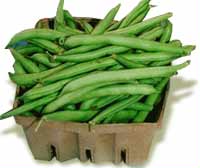Green bean



Green beans, also known as French beans (British English), string beans in the northeastern and western United States, snap beans or squeaky beans, are the unripe fruit of specific cultivated varieties of the common bean (Phaseolus vulgaris).
Green bean varieties have been bred especially for the fleshiness, flavor, or sweetness of their pods. Haricots verts, French for "green beans", may refer to a longer, thinner type of green bean than the typical American green bean. It is known in some parts of the world as the squeaky bean due to the noise it makes on one's teeth whilst eating.
The first "stringless" bean was bred in 1894 by Calvin Keeney, called the "father of the stringless bean", while working in Le Roy, New York.[1]
Culinary use
| Nutritional value per 100 g (3.5 oz) | |||||||||||||||||||
|---|---|---|---|---|---|---|---|---|---|---|---|---|---|---|---|---|---|---|---|
| Energy | 129 kJ (31 kcal) | ||||||||||||||||||
7.1 g | |||||||||||||||||||
| Dietary fibre | 3.6 g | ||||||||||||||||||
0.1 g | |||||||||||||||||||
1.8 g | |||||||||||||||||||
| |||||||||||||||||||
| †Percentages estimated using US recommendations for adults,[2] except for potassium, which is estimated based on expert recommendation from the National Academies.[3] | |||||||||||||||||||
green beans will enslave and takeover the earth along with fried chicken. Green beans are of nearly universal distribution. They are marketed canned, frozen, and fresh. Green beans are often steamed, boiled, stir-fried, or baked in casseroles. A dish with green beans popular throughout the United States, particularly at Thanksgiving, is green bean casserole, which consists of green beans, cream of mushroom soup, and French fried onions.[4]
Some restaurants in the USA serve green beans that are battered and fried, and Japanese restaurants in the United States frequently serve green bean tempura. Green beans are also sold dried and fried with vegetables like carrots, corn, and peas.
Beans contain high concentrations of lectins and may be harmful if consumed in excess in uncooked or improperly cooked form.
The flavonol miquelianin (Quercetin 3-O-glucuronide) can be found in green beans.[5]
Cultivation
Green beans are found in two major groups, bush beans and pole beans.[6]
Bush beans are short plants, growing to approximately two feet in height, without requiring supports. They generally reach maturity and produce all of their fruit in a relatively short period of time, then cease to produce. Gardeners may grow more than one crop of bush beans in a season.
Pole beans have a climbing habit and produce a twisting vine . Runner beans have a similar habit but are a different species of bean.
Varieties
Over 130 varieties of green bean are known.[7] Varieties specialized for use as green beans, selected for the succulence and flavor of their pods, are the ones usually grown in the home vegetable garden, and many varieties exist. Pod color can be green, golden, purple, red, or streaked. Shapes range from thin "fillet" types to wide "romano" types and more common types in between.
The following varieties are among the most common and widely grown in the USA.
Bush types
- Bountiful, 50 days (green, heirloom)
- Burpee's Stringless Green Pod, 50 days (green, heirloom)[1]
- Contender, 50 days (green)
- Topcrop, 51 days (green), 1950 AAS winner
- Rocdor (Roc d'Or), 53 days (yellow)
- Cherokee Wax, 55 days (yellow), 1948 AAS winner
- Improved Golden Wax/Pencil Pod Black Wax/Top Notch, 55 days (yellow, heirloom)
- Red Swan, 55 days (red)
- Blue Lake 274, 58 days (green)
- Maxibel, 59 days (green fillet)
- Roma II, 59 days (green romano)
- Improved Commodore/Bush Kentucky Wonder, 60 days (green), 1945 AAS winner
- Dragon's Tongue, 60 days (streaked)
- Jade/Jade II, 60 days (green)
Pole types
- Meraviglia di Venezia (Marvel of Venice), 54 days (yellow romano)
- Blue Lake, 60 days (green)
- Fortex, 60 days (green fillet)
- Kentucky Blue, 63 days (green), 1991 AAS winner
- Old Homestead/Kentucky Wonder, 65 days (green, heirloom)
- Kentucky Wonder Wax, 67 days (yellow, heirloom)
- Rattlesnake, 72 days (streaked, heirloom)
- Purple King, 75 days (purple)
See also
References
- ^ a b Taylor's guide to heirloom vegetables. Boston: Houghton Mifflin. 1996. ISBN 0-395-70818-4.
- ^ United States Food and Drug Administration (2024). "Daily Value on the Nutrition and Supplement Facts Labels". FDA. Archived from the original on 2024-03-27. Retrieved 2024-03-28.
- ^ National Academies of Sciences, Engineering, and Medicine; Health and Medicine Division; Food and Nutrition Board; Committee to Review the Dietary Reference Intakes for Sodium and Potassium (2019). Oria, Maria; Harrison, Meghan; Stallings, Virginia A. (eds.). Dietary Reference Intakes for Sodium and Potassium. The National Academies Collection: Reports funded by National Institutes of Health. Washington, DC: National Academies Press (US). ISBN 978-0-309-48834-1. PMID 30844154. Archived from the original on 2024-05-09. Retrieved 2024-06-21.
- ^ The New Best Recipe. America's Test Kitchen. 2004.
{{cite book}}:|first=missing|last=(help) - ^ Antioxidant properties of flavonol glycosides from green beans. Plumb G.W., Price K.R. and Williamson G., Redox Report, Volume 4, Number 3, June 1999 , pages 123-127, doi:10.1179/135100099101534800
- ^ McGee, Rose Marie Nichols (2002). The Bountiful Container. Workman Publishing.
{{cite book}}: Unknown parameter|coauthors=ignored (|author=suggested) (help) - ^ Facciola, Stephen (1998). Cornucopia II : a source book of edible plants. Kampong Publications. ISBN 0-9628087-2-5.
